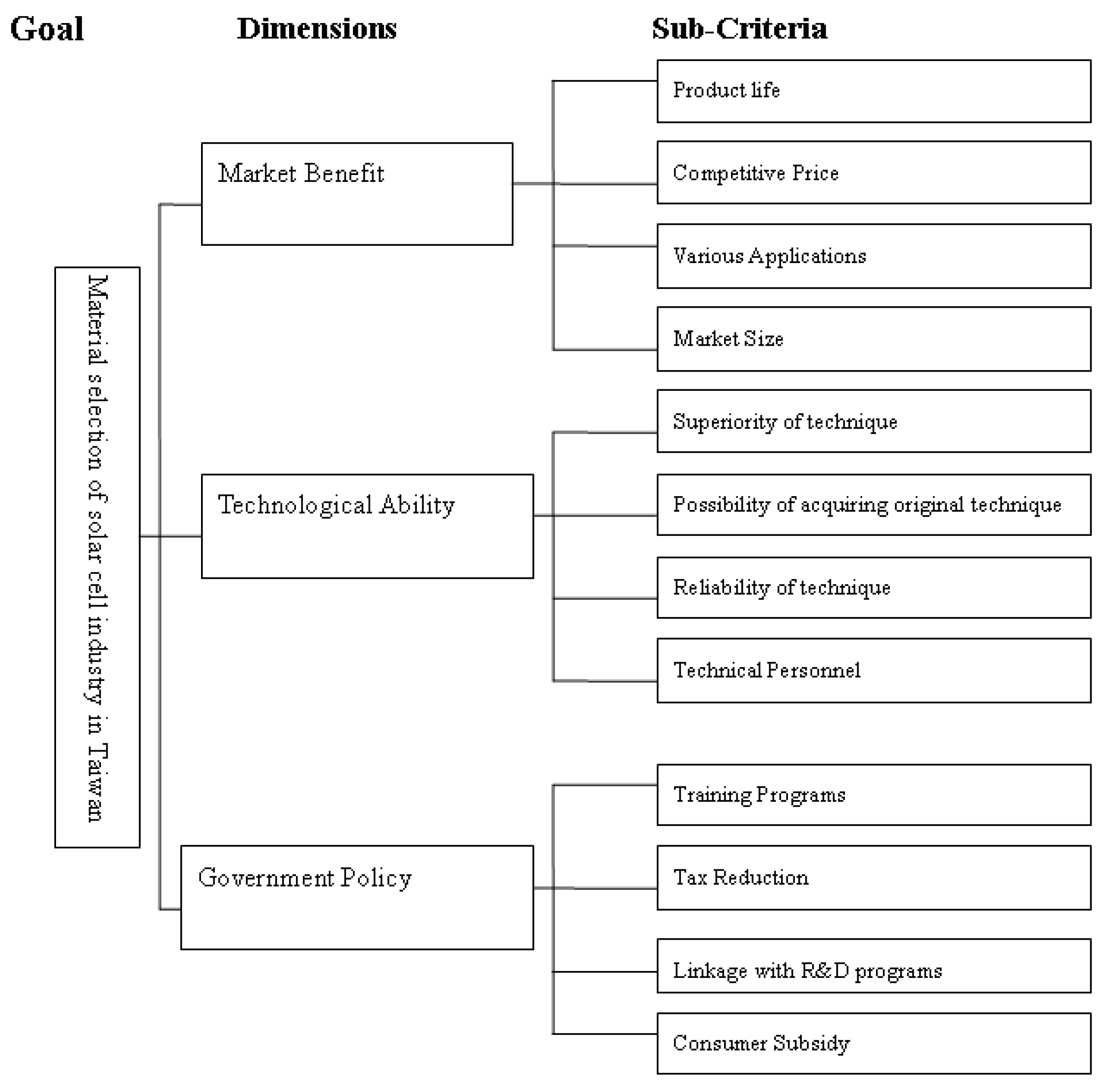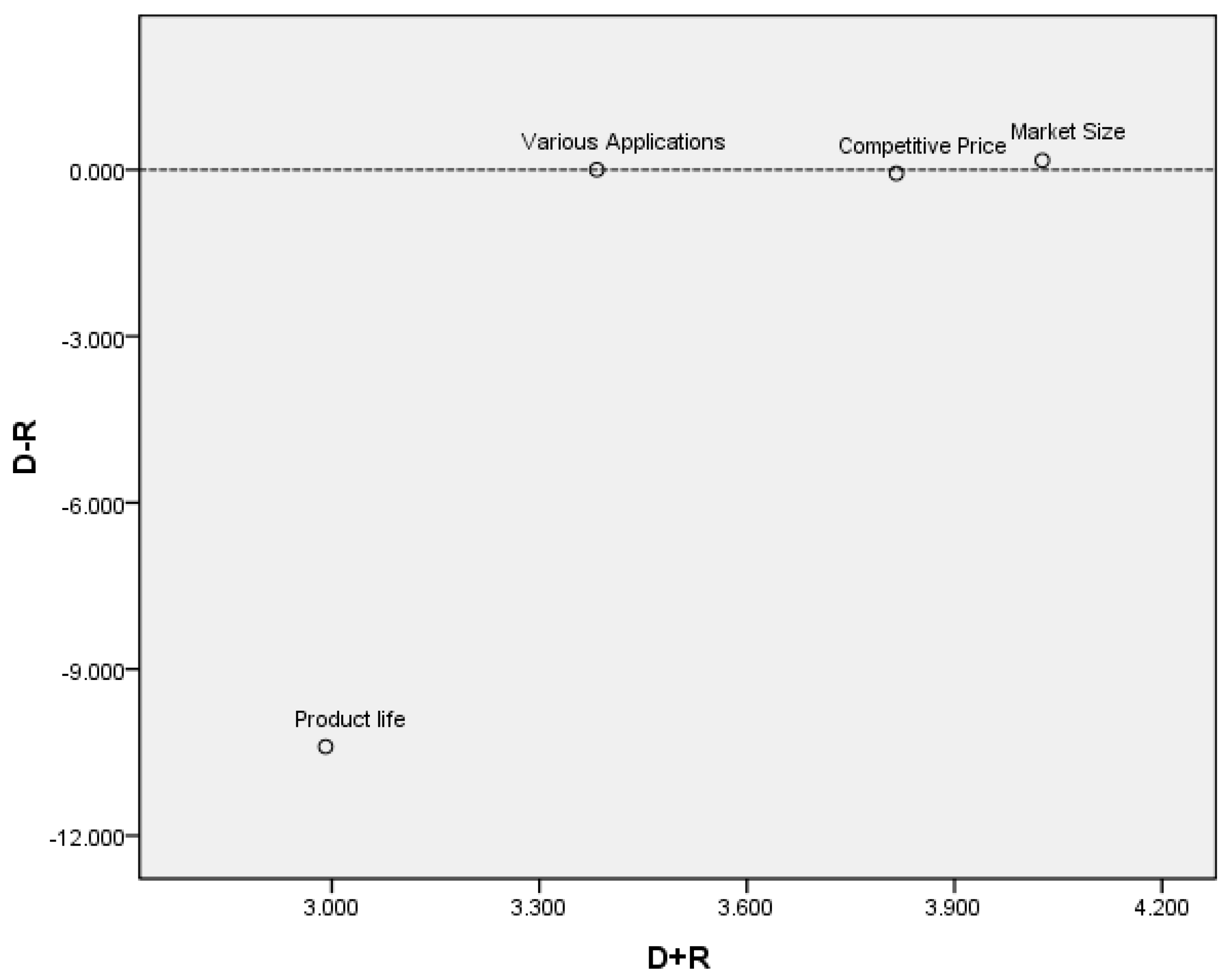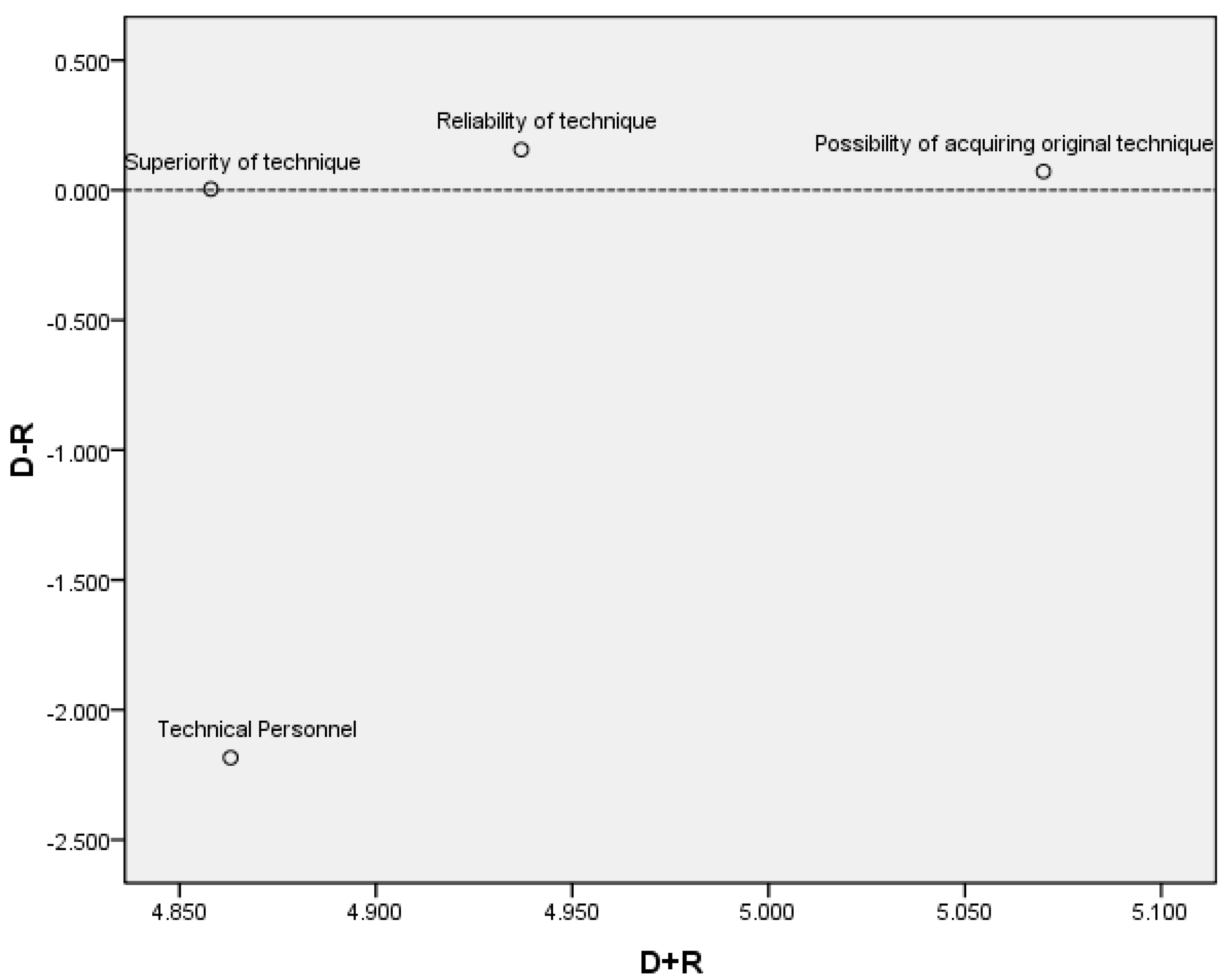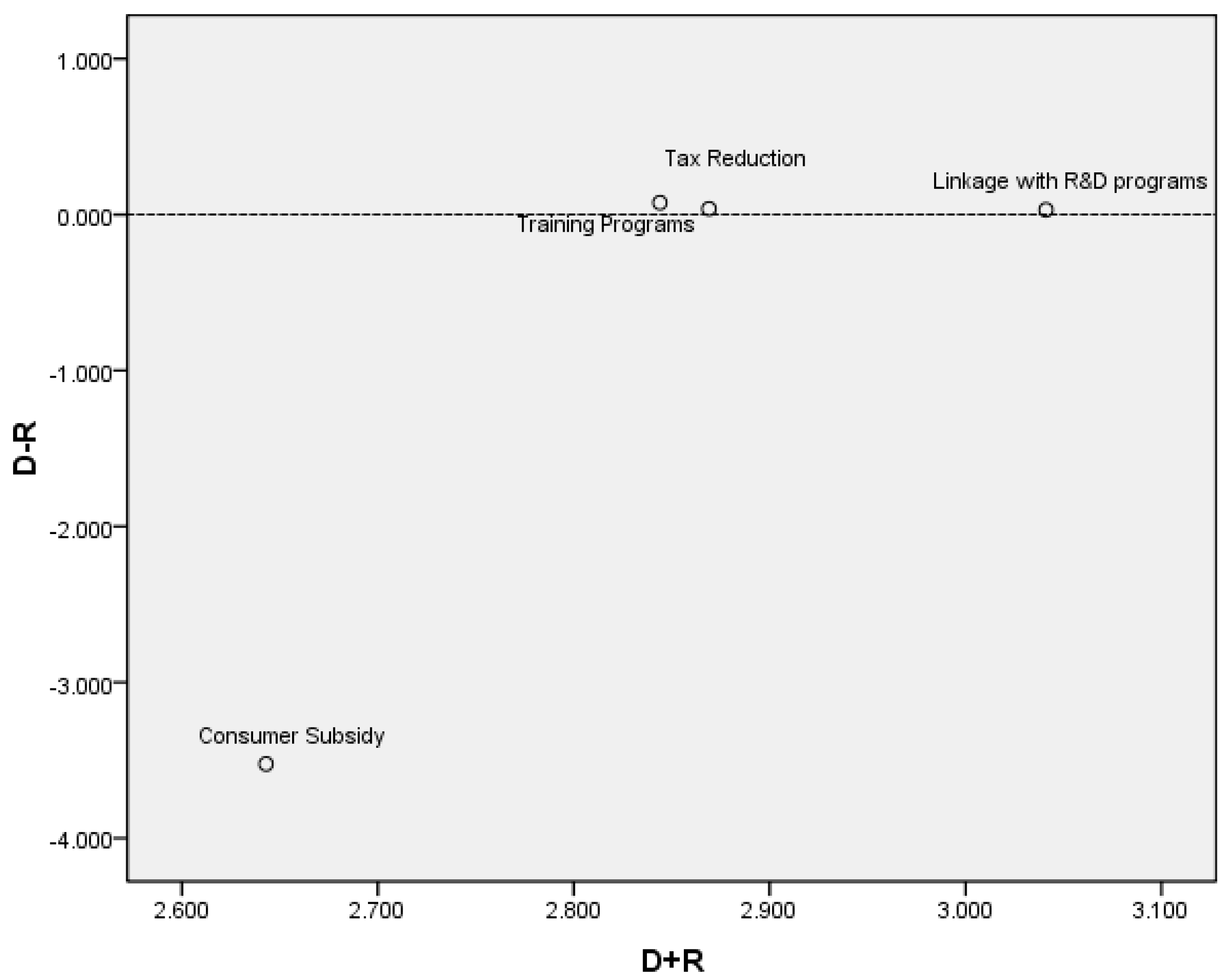3. Research Method
The solar cell business is anticipated to decrease due to the COVID-19 pandemic, whereby major choices regarding modern apparatus within the solar cell industry are likely to stop until the end of the year. After lockdown, numerous producers will confront issues in assembly due to supply chain disturbances caused by a period of stagnation amid the pandemic. Asian providers, especially, will face challenges in sloping up generation due to bottlenecks within the supply of a few key components and delays in conveyance. In this section, we outline this novel half breed assessment and determination using the Taiwanese solar cell industry as a case study.
(1) Define the quality factor characteristics and establish an evaluation scale
The assessment scale for causal relations and a pair-wise comparison of the quality variables is at that point built [
54], according to the scale by Tzeng et al. [
54], Matić et al. [
55].
(2) Obtain interdependent data for all factors using an expert opinion method
These pair-wise comparisons between any two components are indicated by and given a number of 0–4: “No influence (0),” “Low influence (1),” “Medium influence (2),” “High influence (3),” “Very high influence (4),” separately [
56,
57,
58].
(3) Calculate the arithmetic mean matrix
Let us use that the number of factors is
, and the value is from
professionals who judge the factors based on the 0, 1, 2, 3, 4 five-level evaluation scale:
and
represents this influence level of factor
to factor
. Then, sum up and average all
from
experts [
56,
57,
58]. The formula is given below to calculate the arithmetic mean matrix.
(4) Calculate the casual matrix
The casual connection network and the total-relation lattice outline the interrelated effect on each calculation, as in the equation below [
59]. The normalized direct-relation lattice could be obtained as
.
(5) Utilize the casual matrix
Let
the quality of the given y calculate for the direct/indirect network
, and
i,
j = 1, 2, …, n [
59]. Sum the columns and the columns of the casual matrix (T), as in the equation below. It incorporates the coordinate and the roundabout effect, which is the degree of the coordinate or the circuitous effect on the other variables. Once the normalized direct-relation
is obtained, the total-relation matrix
can be calculated, guaranteeing the convergence of
. The casual matrix is as following Formulas (2) and (3) [
60,
61,
62].
(6) Causal diagram
The causal graph is delineated in two dimensions, where the full
is the level pivot, and the contrast
is the vertical pivot, thereby rearranging the complex causal relation into an effectively justifiable visual structure to consider all the issues [
62]. When
is positive and over the x hub, the quality calculate
m has a place to the sort of cause, but when
is negative and underneath the x pivot, the quality figure has a place to the sort of result.
4. Research Results and Discussion
Twelve material selection variables for the solar cell industry in Taiwan. The primary stage included distinguishing how numerous qualities or criteria are included in solar cell material determination. The assessment constructed in segment 2 employing a writing survey and interviews with specialists in Taiwan’s solar cell industry distinguished three measurements and twelve criteria to assess solar cell material determination.
Fourteen specialists were invited to assess the criteria. This investigation was conducted by collecting observational information from several key specialists, including completely different businesses. The industry representation was ideal as all pertinent industry divisions and scholarly analysts (solar cell, electronic and mechanical investigator) were included. A fuzzy DEMATEL strategy was connected to capture the complex connections among these assessment criteria is shown in
Figure 1.
Step 1: Calculate the arithmetic mean matrix
This is also called the initial average matrix that utilizes data from the collected questionnaire to calculate the arithmetic mean matrix. By separately adding up all the interrelated factors for every aspect and then averaging their sum, we obtained the arithmetic mean matrix. Assume that the number of factors is
, and the value is from
professionals who judge the factors based on the 0, 1, 2, 3, 4 five-level evaluation scale:
and
(
i = 1, 2, 3, …, n;
j = 1, 2, 3, …, n) represents the influence degree of factor
to factor
. Then, sum up and average all
from
experts. The calculation formula is given below to calculate the
arithmetic mean matrix. The arithmetic mean matrix framework was obtained for the first-level measurement:
Step 2: Normalizing the casual fuzzy matrix
The linear scale change is utilized to convert the criteria scale into comparable scales. The normalizing the casual fuzzy matrix can be gotten as
. It is expected that at slightest one
i exists. The normalized arithmetic mean matrix was as follows:
Step 3: Establish and analyze the casual model
After calculating normalizing the casual fuzzy matrix, the total-relation framework T can be got. The casual matrix could be ensured that the convergence of
. Let
the quality of the given y be calculated for the direct/indirect network
, and
i, j = 1, 2, …,
n. Add up the columns of the direct/indirect matrix (
T).
Step 4: Utilize the causal matrix
Table 1 portrays the coordinate and circuitous impacts of the three first-level measurements, and their casual connections are shown in the digraph in
Figure 2.
Table 2 shows that government policy is the net cause, while technological capacity and market benefit are the net recipients.
Figure 2 demonstrates that government policy may be the foremost basic measurement, with technological capacity and market benefit influencing each other as well as being influenced by the innovative measurement.
Figure 2 shows that “Government policy” was the most important factor that positively impacted the other dimensions.
The causal associations among the three market benefit criteria are portrayed in
Table 3 and
Table 4 and
Figure 3. The causal associations among the three technological abilities appear in
Table 5 and
Table 6 and
Figure 4, with
Table 7 and
Table 8 and
Figure 5 summarizing the causal associations among the three government policy criteria.
The causal connections among the three second-level criteria of the market benefit are delineated in
Table 3 and
Table 4 and
Figure 3. The causal connections among the three second-level criteria of technological ability are shown in
Table 5 and
Table 6 and
Figure 4, with
Table 7 and
Table 8 and
Figure 5 summarizing the causal connections among the three second-level criteria of government policy.
Table 3 and
Table 4 delineate that different applications and market size measures are the net causes, though product life and competitive cost are the net recipients.
Figure 3 shows that the market size measure may be the foremost basic measurement, with product life and competitive cost influenced by each other as well as by different applications and market sizes.
Figure 3 shows that “Various applications” and “Market size” impacted “T Competitive price” and “Product life”, respectively. In this analysis, “Market size” was the most important factor that positively impacted the other factors. Accordingly, it showed that in the market benefit sub-aspects, “Market size” was the key factor that impacted the other factors the most.
Table 5 and
Table 6 show that the superiority of the technique, the possibility of acquiring an original technique, and reliability of the technique belong to net causes, though technical personnel belong to a net collector.
Figure 4 shows that the reliability of the technique may be the foremost basic measurement.
Figure 4 shows that “Reliability of technique”, “Possibility of acquiring original technique”, and “Superiority of technique” impacted “Technical personnel”, respectively. In this analysis, “Reliability of technique” was the most important factor that positively impacted the other factors. Accordingly, it showed that in the technological ability sub-aspects, “Reliability of technique” was the key factor that impacted the other factors the most.
Table 7 and
Table 8 portray that training programs, tax reduction, and linkage with R&D programs are the net causes, though consumer subsidy could be a net recipient.
Figure 5 indicates that training programs may be the foremost basic measurement.
Figure 5 shows that “Training programs”, “Linkage with R&D programs”, and “Tax reduction Meet future mission” impacted “Consumer subsidy”, respectively. In this analysis, “Training programs” was the most important factor that positively impacted the other factors. Accordingly, it showed that in the government policy sub-aspects, “Training programs” was the key factor that impacted the other factors the most.
This experimental approach endeavored to distinguish the major components for material selection within the solar cell industry utilizing the Taiwan solar cell industry as the case study. The investigation determined that the major causal measurement is government policy (D3); that is, the two measurements involve more improvement room for enhancement and comparison to other strengths, permitting businesses to create more distinctively and successfully. The committee determined that “market size” is the most causal measurement for solar cell material determination within the market benefit measurement (D1). Porter (1998) contended that an advanced domestic market is a vital component for competitive advantages, as companies that confront modern market applications offer prevalent items since the domestic market requests quality and the vicinity to such shoppers, empowering the firm to better meet clients’ needs. The reliability of the technique is the foremost basic factor for solar cell material determination within the technological ability measurement (D2). The quality of the gear, its upkeep, the solar cell framework plan, and how it is worked play major roles in reliability quality. The reliability quality of the solar cell framework is a basic measure for assessment. The specialists also demonstrated that the training program might be a significant and determinative component for solar cell industry material determination. Effective human asset capability is vital for a high-tech industry; hence, the training arrangement may be a productive arrangement device to move forward proficient abilities and capabilities.
5. Conclusions and Remarks
We take solar cell materials for our case purposes. Photovoltaics (PV) comprise the technology to convert sunlight directly into electricity. The term “photo” means light and “voltaic,” electricity. A photovoltaic (PV) cell, also known as a “solar cell,” generates electricity.
This study presents a solar cell material assessment for the solar cell industry. The DEMATEL technique can abuse latent information to the total, such as master encounters and instinctual. This thinks about too recognized the key calculate for deciding the ultimate sun oriented cell fabric choice both from strategy and reality information. The proposed technique employs the least resource dedication, centers on the center driving calculation within the framework, and recognizes the course of change for the determination of the ideal solar cell material. The components that impact solar cell material choice are complicated, so passive information is more solid than evident information in decision-making. The above-mentioned hypothetical models contribute to our understanding of material choice components. According to the interaction between major competencies of the fuzzy DEMATEL method, the managers can effectively manage in a cost-saving way, thereby increasing the competitive advantage of the solar cell industry.
The solar cell industry material determination comprises numerous connection components. This study showed that the government policy impact is of most concern, confirming the solar cell material determination system [
57,
58,
59,
60]. Future inquiries should apply this crossover to confirm its appropriateness to other rising advances. The proposed approach is appropriate for managing complicated choice issues with material determination criteria.
With respect to the solar cell industry, policymakers must consider the key variables and their impacts on the other circuitous measurements. For the most part, enacting powerful components can more effortlessly result in enhancement, but circuitous components restrict commitments to ceaseless invigorating development. In this case, “government policy” is the most causal measurement which unequivocally coordinates influencers in all other measurements.
The results show that “Government policy” was the most important factor that positively impacted the other dimensions. The government ought to act as a catalyst, enabling companies to raise their objectives and move to higher levels of competitive execution [
61]. They should energize companies to develop their execution, fortify early requests for progressed items, center on specialized calculate creation, and invigorate nearby competitions by constraining coordinate participation and implementing anti-trust directions. They should also provide the desired infrastructural needs for improvement [
62,
63], executing broker arrangements and preparing approaches. Broker approaches can back the foundation of relations between firms through the creation of stages for discourse [
64,
65,
66], which promotes knowledge-enhancing organization relations through public-private associations, such as incubators, venture capital exercises, college research facilities, and other inquiry about research insertions. The presence of innovation incubators makes it simpler for scholarly staff to misuse knowledge-based commerce thoughts, hence overcoming the barriers that repress commercial coordinate application of scholarly investigation [
67,
68,
69,
70,
71]. Incubators, regularly found between an inquiry about colleges and industry, progressively intercede development, and their representatives from academia and industry, and combine hones and proficient standards from both perspectives in their day-to-day work [
72,
73]. Rothschild and Darr [
72] offer a complex show of the part of hatcheries to make strides eminent progress, proposing that the incubators serve as a bridge meddle the founded and industry, as well as a portion of a more extensive arrangement of advancement. Incubator laborers and supervisors exchange information and know-how between industry and colleges.
College research facilities and other investigation centers give firms with simpler get to logical skill and research, in this way, encouraging the exchange of information into commercial applications [
74,
75,
76]. The role of colleges has progressively been considered, and they are imperative since their common mission is instruction and inquiry, as well as their potential to serve as hubs for business and science-industry exchange [
77,
78,
79]. Venture capital can aid to overcome office and data issues among businesses, trailblazers, and agents. Venture capitalists enter a company as it were against a stake in proprietorship and an understanding to require a dynamic portion in administration [
80,
81]. Kou and Wu [
74] contended that within the early arrangement of inventive firm improvement, potential financial specialists contend with issues surveying the quality of a thought, which tends to depend on particular intangible resources (e.g., brand names, licenses, the brain or the stamina of the business visionary) or ventures (R&D, program or organizational alter), and the capacity of the venture to procure a finishing first-mover advantage relative to competing performing artists and items. Commerce victory at this organization may be doable with the engagement of dynamic and understanding speculators, who bring monetary value as well as non-financial resources such as significant encounters, business-related abilities, complementary systems, and observing capacity. Kou and Wu [
74] highlight that venture capitalists can support the energetic organization by empowering the fast development of promising, high-risk youthful firms. In contrast, industrial systems can serve as a stage for the advancement of wander capital markets by making an environment in which numerous performing artists with complementary abilities can attempt modern thoughts and recognize unused accomplices. For the venture capital firm, the arrangement may frame prolific ground for obtaining or sending data and progressing business visionaries inside their field of specialization. Venture capital stores give administration rather than capital help. Once the undertaking is successful, they offer their holding within the company to create a benefit. Taiwan has built up a creative capital and bring forth environment, comprising a culture of entrepreneurial capacity [
82,
83]. Moreover, Taiwan’s entrepreneurial brooding education has effectively backed and hatched various solar cell companies.
The brokers are masters, but, in most cases, brokers work for workplaces presently serving small and medium sizes companies. Broker approaches point to enable value-enhancing trade and collaboration that would have been finished inside the nonappearance of exercises. The broker courses of action join the creation of stages, security of intellectual property rights, and back of knowledge-enhancing organizational linkage. The stage can cultivate industry improvement, not as it were, empowering and encouraging the development of mechanical systems but also underpins outside associations. In expansion, mental property changes may be changed to supply both the teacher and person analysts with a motivation to collaborate. The linkages of the industrial cluster give discharge time, as well as making potential learning and benchmarking openings within the industry.
Moreover, training programs are a critical part, and fruitful human asset capability is vital for the sun-oriented cell industry. Subsequently, the training arrangement may be a proficient arrangement apparatus for progressing proficient abilities and capabilities. Training arrangement centers update the abilities and competencies basic for compelling SME clusters. Government organizations need to make human resources, making a more talented and specialized labor oblige, and construct cluster aptitudes centers. Cluster aptitudes centers might end up as the lead substances for looking over industry needs, making unused educational programs, remaining in touch with cluster committees, overhauling aptitudes benchmarks, sharpening benchmarking in other places, and collecting information around cluster occupations and programs.
In this analysis, “Market size” was the most important factor that positively impacted the other factors. Accordingly, it showed that in the market benefit sub-aspects, “Market size” was the key factor that impacted the other factors the most. Market estimate conceivably plays the foremost critical part in shaping and building a solar cell industry. The market measure points to extend openness to modern thoughts and imaginative arrangements. One instrument for the market-side approach is open procurement. The government ought to increment the current cash stream of imaginative firms by buying more at higher costs, while to invigorate R&D and advancement in sectors that effortlessly raise outside capital, the government ought to commit to an arrangement that increments the imaginative firms’ future anticipated benefits, for illustration, by promising to purchase future imaginative products at higher costs. Government procurement ought to make costs, and amounts requested responsive to quality positioning alterations: top-quality items ought to be ensured prompt benefits while, for out of date products, the open buyer ought to deal for exceptionally competitive costs. Government consumption ought to diminish anticipated profit. Market size conceivably plays the foremost critical part in shaping and building a solar cell industry. The market measure points to extend openness to unused thoughts and inventive arrangements. One instrument for the market-side approach is an open acquirement. Vaidogas and Šakėnaitė [
75] list a few perspectives that ought to be considered when building up an arrangement for acquirement for the industry’s development. To fortify R&D and advancement in financially obliged portions, the government has to increase the current cash stream of creative firms by buying more at higher costs, whereas to brace R&D and progression in portions that viably raise exterior capital, the government ought to commit to a course of action that increases the creative firms’ future expected benefits, for illustration, by promising to buy future innovative merchandise at higher costs. Government acquirement ought to make costs and sums asked responsive to quality situating modifications: top-quality things should be guaranteed speedy benefits whereas, for out of date merchandise, the open buyer ought to bargain for uncommonly competitive costs.
The solar cell material determination handle is composed of numerous connection components. A case considers of Taiwan selecting the foremost reasonable materials was actualized to illustrate the proposed crossbreed strategy. It can give enlightening and commonsense recommendations to the solar cell industry for assessing and selecting materials. A case study of the Taiwan solar cell industry selecting the most suitable materials was implemented to demonstrate the proposed hybrid method. It can give commonsense recommendations to the solar cell industry for assessing and selecting materials.
Different applications have noteworthy impacts on sun based cell materials evaluation. This appears that firms ought to center on whether the sun-powered cell fabric is congruous with their current esteem framework, past involvement and reliability with the degree of potential buyers. Compatibility has been recognized as a critical indicator for modern innovation acknowledgment. The dye-sensitized solar cells provide a technically and economically credible alternative concept to present-day p–n junction photovoltaic devices. Dye-sensitized solar cells have attracted a lot of interest in recent years. Dye-sensitized solar cells have the advantages of lower costs and lower energy consumption in production processes than poly-silicon solar cells.
Microcrystalline silicon (μc-Si:H) stored at moo temperatures (<250 °C) is an alluring fabric for sun-powered cell applications. Microcrystalline silicon (μc-Si:H) can be stored utilizing the same statement procedures utilized for shapeless silicon, but, compared to the last mentioned, it offers upgraded infrared retention and a moved forward solidness against light drenching. In any case, depending on the stated conditions and sort of substrates, microcrystalline silicon (μc-Si:H) may display different morphologies (grain estimate, shape, surface morphology, etc.). Careful fabric development control is hence required for ideal gadget execution.
GaAs features a precious structure comparable to that of silicon. An advantage of GaAs is that it has light assimilation. GaAs has higher vitality change effectiveness than crystal silicon, coming to almost 25 to 30%. GaAs is additionally prevalent in space applications where solid resistance to radiation harm and effectiveness are required.
Our research was collected in one industry, and there are outstanding contrasts between businesses, and the inquiry about discoveries may subsequently shift between nations. The proposed approach presents impediments in terms of the little test estimate, so future investigation should be conducted to test the appropriation variables displayed considering utilizing diverse strategies and larger test sizes.











